 |
|

|
 |
TABLE of CONTENTS
 |
RTMC works to keep traffic moving smoothly, safely |
|
This video describes how the Regional Transportation Management Center in Roseville helps to reduce crashes and congestion on the roads, while providing accurate and timely traffic information. Video produced by Rich Kemp |
|
 |
|

|
 |
TABLE of CONTENTS
 |
Annual transportation conference offers variety of topics for public, private sector staff |
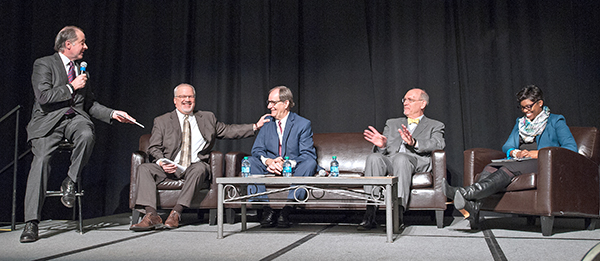
Commissioner Charlie Zelle, left, kicked off Minnesota's Transportation Conference March 1-2 in St. Paul with a panel discussion of how a multimodal transportation network is critical for the health of Minnesotans, and for the state's overall environmental sustainability and economic prosperity. Joining Zelle were commissioners from four Minnesota state agencies: John Linc Stine (Pollution Control), David Frederickson (Agriculture), Ed Ehlinger (Health) and Shawntera Hardy (Employment and Economic Development). Photo by David Gonzalez |

At left, District 8/Willmar Transportation Engineer Jon Huseby speaks with District 7/Mankato Transportation Engineer Greg Ous during a break at Minnesota's Transportation Conference. Photo by David Gonzalez |
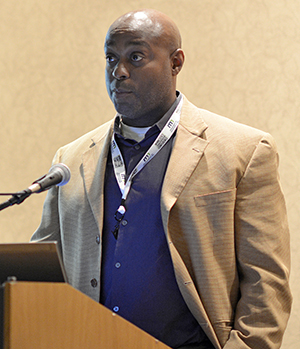
Ashanti Payne, Office of Civil Rights, talks about advancing equity through contracting and workforce development at the transportation conference March 1. Photo by David Gonzalez |
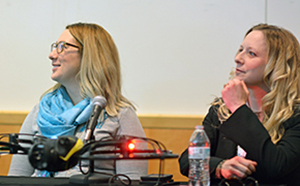
During a breakout session at the transportation conference, Tara Kalar, Office of Chief Counsel, and Jennifer Wells, Bridge Office, discuss using unmanned aircraft systems for bridge inspections. Photo by David Gonzalez |
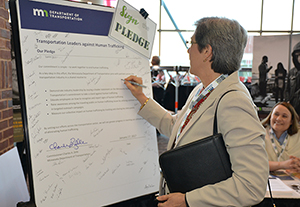
Deputy Commissioner and Chief Engineer Sue Mulvihill signs a poster-size version of the "Transportation Leaders Against Human Trafficking" pledge that Commissioner Charlie Zelle signed Jan. 17 on behalf of all MnDOT employees. Seated behind Mulvihill is Angela Forsythe, Office of Chief Counsel, who was part of the team that drafted the pledge. Photo by Judy Jacobs |
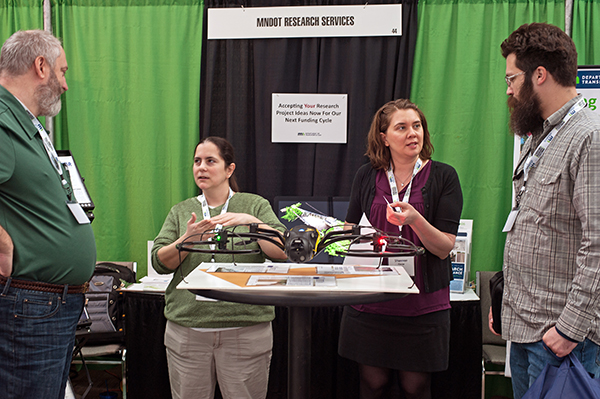
Peter Morey, Planning and Data Analysis; Karen Nienstadt and Shannon Fiecke, Research Services and Library; and James Pontius, Human Resources, talk shop at the Research Services booth at Minnesota's Transportation Conference March 1. Photo by David Gonzalez |
|
 |
|

|
 |
TABLE of CONTENTS
 |
Central Office, District 3 employees eligible for vacation donation |

Rosemarie Merrigan, Office of Equity and Diversity, is eligible for the state vacation donation program. Photo by David Gonzalez |
Rosemarie Merrigan, Office of Equity and Diversity, and Tina Warwick, employee development specialist in District 3, are now eligible for the state vacation donation program.
Merrigan, has been diagnosed with pancreatic cancer and is currently unable to work. She has been receiving chemo and other therapies and recently underwent major surgery. She has worked for MnDOT for 12 years.
Warwick has been a MnDOT employee since April 1986 and works out of the St. Cloud Office. She’s undergoing treatment and therapy for a life-threatening illness.

Tina Warwick, employee development specialist in District 3, is eligible for the state vacation donation program. Photo courtesy of District 3 |
Merrigan and Warwick have exhausted all of their sick and vacation leave. Vacation hours from state employees, who may donate up to a total of 40 hours per fiscal year to one or more eligible employees, will help them stay on the payroll.
Also eligible for the vacation donation program are MnDOT employees Michael Peterson, transportation generalist in District 3, Emmett Trudeau, transportation generalist in the Metro District, William Loher, geotechnical engineering section crew supervisor in the Office of Materials and Road Research, and Curt Pape, transportation program supervisor senior in the Office of Maintenance. Check out the articles for Peterson, Trudeau, Loher and Pape in previous Newsline articles.
To donate vacation hours, go to the Employee Self Service Web site and click “Other Payroll” and then “Leave Donations.” The site also allows employees to view a list of all state employees eligible for the program and to enroll as a recipient. |
 |
|

|
 |
TABLE of CONTENTS
 |
MN.IT Services to upgrade Outlook to Office 365 for Government beginning March 17 |
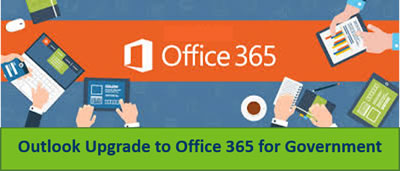
All MnDOT Outlook mailboxes will be upgraded to the new Office 365 for Government cloud beginning March 17. |
All MnDOT Outlook mailboxes will be upgraded to the new Office 365 for Government cloud beginning at 6 p.m. on March 17.
MN.IT Services will keep you informed on what needs to be done. Watch for email updates, check out the IT Services Storefront for articles and training, and keep your eye out for a fun MN.IT March Madness poster.
What to do prior to the upgrade
- Delete shared calendars for any individuals outside of MnDOT. You can find instructions on how to delete an Outlook calendar in the IT Services Storefront.
- SHUT DOWN your computer before 6 p.m. Friday, March 17.
- DO NOT use Outlook or Outlook Web App from 6 p.m. Friday, March 17, until 6 a.m. on Monday, March 20.
What to do following the upgrade
- When you open Outlook for the first time, you will be prompted for credentials. You will receive detailed instructions on the login procedure prior to the upgrade.
- If you have a state-issued mobile device that you use to access your work email and calendar (iPhone, iPad), you will need to re-connect to the new system. Again, detailed instructions will be made available prior to the upgrade.
MN.IT Services’ goal is to make the transition as smooth as possible for everyone to ensure your day-to-day business is not adversely affected. |
 |
|

|
 |
TABLE of CONTENTS
 |
A brand is more than a logo |
|
By MnDOT web and graphics team
It’s been nearly three months since MnDOT began to transition to the new state logo, and employees are now starting to think about adding the new logo to brochures, posters and other print material.
Each week the Communications web and graphics team receives dozens of requests from staff requesting the file for the logo so they can place it on print material. Our typical reply is “Great! You’re recognizing the importance of the logo.” But brand is more than a logo. The logo works with other elements to create a brand. Simply swapping out the logo on an existing brochure or print document will likely look out of place and will not accomplish the larger rebranding envisioned by the governor’s office.
If you contact the Communications office for help using the new logo (and we hope you will!), here are some of the key elements a graphic designer will consider. Some are very straightforward and some are more subtle.
Tone
Good design conveys emotion and might vary from document to document. For example, the tone of an official MnDOT policy might be different than a document to describe an upcoming construction project. The policy may be slightly more authoritative and the construction update might feel more friendly and accessible. Done correctly, both will still be easily identified as a MnDOT document and convey the idea that government is credible AND approachable.
Color
The new brand relies on a specified palette of colors and tones--the primary colors are Minnesota Blue and Minnesota Green, black and white. The palette can also be expanded through the use of tints (adding white), tones (adding gray) and shades (adding black). All of the type and most of the graphic elements on a piece should use these colors. Accent colors provide additional choices for use in images, charts and graphs. The goal is a clean and fresh look. If color is done correctly, someone should be able to identify it as a state agency product even if they cannot see the logo. And while a little color adds clarity and interest to a document, too many colors can create visual chaos and make the document harder to read.
Font
The new brand includes a font to be used for headings in major reports and brochures, and a family of fonts to be used in other cases. Using too many font sizes or types in one document can also create confusion.
Design
When designing for the new brand, simplicity rules. Well-designed documents almost always have one or two focal points and plenty of space for your eyes to rest--we call this “white space.” Too much bold or underlined text, screaming red images, etc., can confuse the reader.
Tone, color, font and design are just some of the elements we will consider as we help you develop or redesign your print material. Contact us by filling out this quick online form ihub.dot.state.mn.us/communications/communicationsform.php or by contacting one of us in person or by phone.
In a future issue of Newsline we will talk about language and how using Plain Language can help convey your message.
Resources
Download new logos mndot.gov/mediaroom/logos.html
Templates for letterhead, memos and more ihub/communications/mndottemplates.html
More about the state brand initiative http://mn.gov/portal/brand/
We’re here to help
Adam Peterson (Oie)
Libby Schultz
Cassie Petersen
Becky Niyukuri
Greg Ruhland
Kay Korsgaard
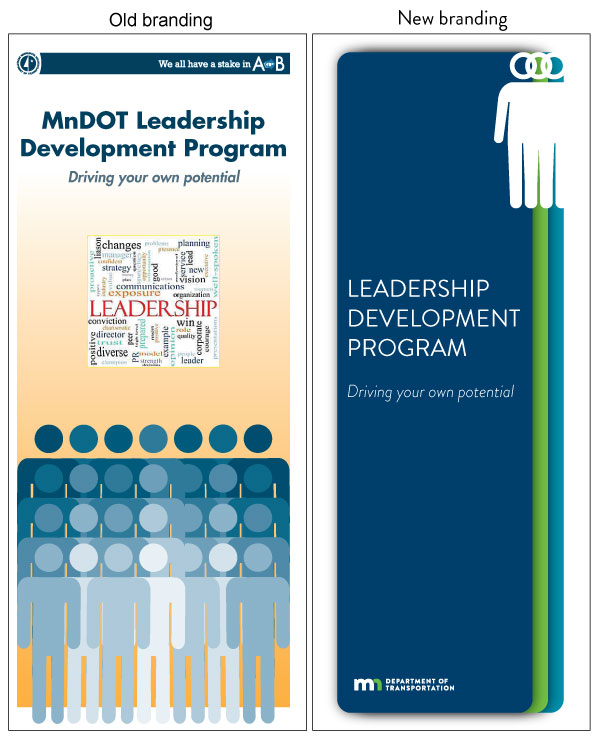
Tone: The brochure with the new branding still includes the human element from the old brochure, but uses fewer colors and much more space between the figures, the words and the logo.
Color: The only colors used are the Minnesota Blue, Minnesota Green, white and one of the accent colors. It’s much cleaner, easier to read and more professional looking.
Font: The old branding used more chunky (bold) fonts and the new branding uses lighter fonts. It helps keep the look clean and simple. You can make words look more important just by making the font size larger — no need for bold, colorful or underlined text. |
|
 |
|

|
 |
TABLE of CONTENTS
 |
Opportunities for earning professional development hours at your fingertips |
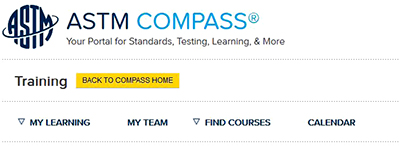
Engineers and other professionals who are required to complete and self-report professional development hours now have access to additional E-learning modules through the ASTM DOT Compass Portal. Contact Marilee Tuite, MnDOT Library, at 651-366-3791 or marilee.tuite@state.mn.us, for more information. |
Since August 2016, MnDOT employees have been able to access ASTM standards and select American Association of State Highway and Transportation Official publications through the ASTM DOT Compass Portal. The portal also offers an E-Learning module with about 40 courses based on ASTM standards. Completing a course generates a certificate that indicates one Professional Development Hour. This is a unique opportunity for engineers and other professionals who are required to complete and self-report PDHs.
To access the E-Learning module, sign in to ASTM DOT Compass Portal at https://compass.astm.org. On your dashboard, click E-LEARNING to go to the course list. From there, you can open Building and Construction to see six testing programs that each contain several courses related to an ASTM standard practice or test method. Some courses contain demonstration videos. It is possible to start a course and finish it later; progress will be saved if the user exits the course via the Exit Course link. For any questions about E-Learning or accessing ASTM DOT Compass Portal, contact Marilee Tuite in the library at 651-366-3791 or marilee.tuite@state.mn.us. This iHub page can answer some FAQs: http://ihub/library/ASTM-Portal.html.
The first year of access to the ASTM DOT Compass Portal was made possible by funding from a Research and Implementation Project. This project is evaluating usefulness of the online Portal before, during, and after the subscription access period. One evaluation method is the current post-assessment survey that is open until March 14: https://www.surveymonkey.com/r/PortalPostAssessment2017. The survey is intended to be completed by MnDOT employees who use ASTM standards or AASHTO publications in their work. MnDOT management will use results of the evaluation to help determine whether to invest in a continuation of the Portal subscription after July 31, 2017. |
 |
|

|
 |
TABLE of CONTENTS
 |
On the job: Kevin Kampa ensures safe shipment of hazardous materials by rail |
By Marcia Lochner, Office of Freight and Commercial Vehicle Operations
|
Do you or a co-worker have an interesting job to share with readers? Send us your ideas, and we’ll contact you for more information.
Recent employee profiles:
|
|

|
 |
TABLE of CONTENTS
 |
Top 10 things you may not know about MnDOTís social media |
By Kristi Loobeek
10. 65% of MnDOT’s Facebook fans are women, 20% of whom are between 35 and 44 years old.
9. All MnDOT districts have their own regional Twitter accounts to provide local news, road condition information and project updates. The accounts also give the public a new way to ask questions and get answers. District public affairs coordinators manage their respective accounts, while @mndotnews, MnDOT’s statewide account, has multiple Central Office contributors.
8. 47% of people who visit the MnDOT Facebook page do so from mobile devices; 53% use computers.
7. MnDOT has an Instagram account that is used to promote safety messages using photos and graphics (@mndot).
6. The @MnDOTnews Twitter account has more than 25,000 followers.
5. MnDOT has a dedicated social media coordinator who oversees, safeguards and contributes to MnDOT’s various social media channels.
4. Combined, the videos on the MnDOT YouTube channel have more than 1.5 million views.
3. MnDOT is experimenting with posting in multiple languages. With the help of a consultant, we recently posted an English and a Spanish version of an open house promotion targeted to a historically Hispanic community.
2. MnDOT has a company LinkedIn page. The page is used to give an inside look at MnDOT’s company culture, publicize upcoming career events and promote hard-to-fill positions.
1. The all-time, highest engaging MnDOT Facebook post was the tribute to Prince in April 2016. The post has reached more than 5.9 million people.
For more information, contact Kristi Loobeek, social media coordinator, Office of Communications, at kristin.loobeek@state.mn.us.

The highest engaging MnDOT Facebook post was the tribute to Prince in April 2016. The post has reached more than 5.9 million people. |
|
 |
|
| |
|



